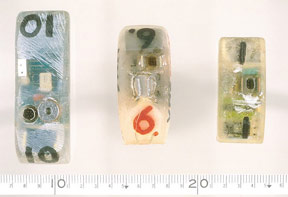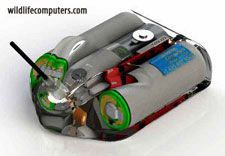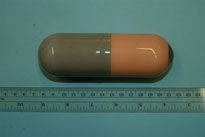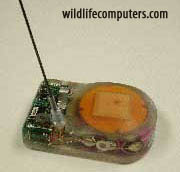 Tag Types
Tag Types
Telemetry tags help scientists discover what animals are doing, where they go, and what their environments are like when they cannot see them. These tags come in a variety of shapes and sizes. They are sturdy in order to withstand the harsh conditions where animals live. Researchers attach tags on the outside of animals with clips, straps or glue or they put tags inside the animal’s body using surgery or by other means. Whether the tag is inside or outside and how it is attached depends on the animal, the tag type, and what the researcher is studying.
Two Types of Telemetry Tags: Storing and Sending
Telemetry tags collect information. Like a computer, tags can store data in memory or they can send data to a satellite or handheld receiver. Tags that store information are called archival tags; tags that send information are called transmitting tags or transmitters. When scientists use archival tags, they must recapture the tagged animal to retrieve the information stored inside the tag. Since this can be disturbing to the animal, many tags transmit data by wire, radio or even by sound. Researchers can retrieve this information with a receiver only if they are in close range of the animal.
Archival Tags
Modern archival tags contain microcomputers that record and store data about an animal or its environment. These tags have the advantage of being much smaller and can store several years’ worth of data on a very fine scale. Generally, the researcher must recover the tag to download the data. If the tag is implanted inside the animal, this may require a second surgery for tag removal.
 Satellite Telemetry
Satellite Telemetry
Satellite tags are the only transmitting tags that researchers can use to get information without recapturing the animal or having to get very close to it. Satellite telemetry allows around the clock animal monitoring anywhere on the planet. Satellite transmitters often measure and temporarily store information about the animal before sending it on to a satellite. These tags can use different satellites orbiting the Earth such as the Iridium Satellite Phone system or the ARGOS system. To send data, tags send an electromagnetic pulse through the antenna, much like a radio wave, that the satellite can receive and decode. The antenna must be out of the water with clear access to the sky in order to transmit to a satellite. A receiving station on Earth sends the decoded information on to the laboratory, often by email. The ARGOS system also gives the location of the tag.
Archival - Satellite Tags
Some archival tags are also combined with satellite transmitters to eliminate the need to recover the tag. They first store data for extended periods of time and only much later send their data to orbiting satellites.
 PAT (Pop-Up) Tags
PAT (Pop-Up) Tags
Examples of such combination tags are pop-up archival tags or PATs placed on the outside of the animal. PATs can record data for many weeks or months without transmitting. This is useful for animals that never come to the ocean surface such as sharks or tuna. At a pre-programmed time, the tag pops off, floats to the surface, and transmits its data to a satellite.
 Life History Transmitter (LHX) Tags
Life History Transmitter (LHX) Tags
Life history transmitters or LHX tags are another example of a combination archival-satellite transmitting tag. Specialized veterinarians implant the LHX tags into the animal by surgery. The LHX stores data throughout the animal’s entire life. Only after the animal has died do these tags come out of the dead body, float to the surface, and begin to transmit all of their stored data.
Other Transmitting Tags:
 GPS Tags
GPS Tags
GPS Tags help track animal movements and give location information. GPS tags have their own global positioning system (GPS) inside the tag, which receives signals from multiple orbiting satellites to determine a location. This is the same GPS technology as modern smart phones or the handheld GPS devices we use for navigation. GPS tags are either archival or satellite tags depending on what they do with the location information. Typically, GPS satellite tags can only provide a location if they are in air and uncovered to communicate with satellites. This limits their use in aquatic animals to those that come to the water’s surface.
VHF Radio Tags
Radio telemetry tags attached to the outside of an animal help scientists to track its movements. These work by sending a radio wave pulse from the tag to a receiver with directional antenna (imagine a radio). The receiver picks up this pulse and makes a beeping sound. The receiver, like a radio, is tuned to a specific “station” or channel that matches the same channel on the animal’s tag. As the scientist with the radio antenna receiver approaches the animal, the receiver beeps more loudly. The louder the beep, the closer the animal is. This allows scientists to track their study animal and to see in what direction the animal is moving. To locate the animal, the scientist must be in close range and have their receiver pointed in the correct direction.
Acoustic Tags
Acoustic tags work as an identification tag and/or track movement. Acoustic tags are based on sound and work from outside or inside the animal’s body. Most commonly they are implanted. The tag makes a sound or “ping” called an acoustic pulse. An underwater listening device called a hydrophone picks up this pulse. Acoustic tags work well for locating animals such as fish that spend the majority of their time underwater since sound travels well through water. The hydrophone must be nearby the animal or the animal must pass by the hydrophone closely in order to “hear” them. Scientists use these tags to count the number of animals that pass the hydrophone at a fixed location such as a dam or they count the number of times a specific animal passes the fixed hydrophone. Alternatively, researchers can use a non-fixed hydrophone to search for an animal. However, this only works well if the animal is close by, and they know its location. Recently, very fancy acoustic tags can actually transmit stored data using sound waves.
PIT Tags
Researchers use the same technology animal shelters use to identify lost animals to identify individuals. The PIT (Passive Integrated Transponder) tag contains a microchip with an electronic identification code. The veterinarian, using a needle, puts a small chip the size of a rice grain underneath the animal’s skin. When the pet gets lost, the animal shelter worker can wave a tag reader over the pet to get the identification code. These codes are registered in a computer database that gives information about the pet and how to contact the owner. Scientists use the same method to identify individual animals. PIT tags eliminate the need to mark the animals externally in order to identify them. However, they do require close contact with the animal in order to read the tag.